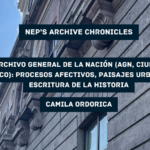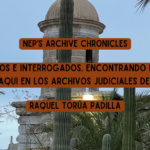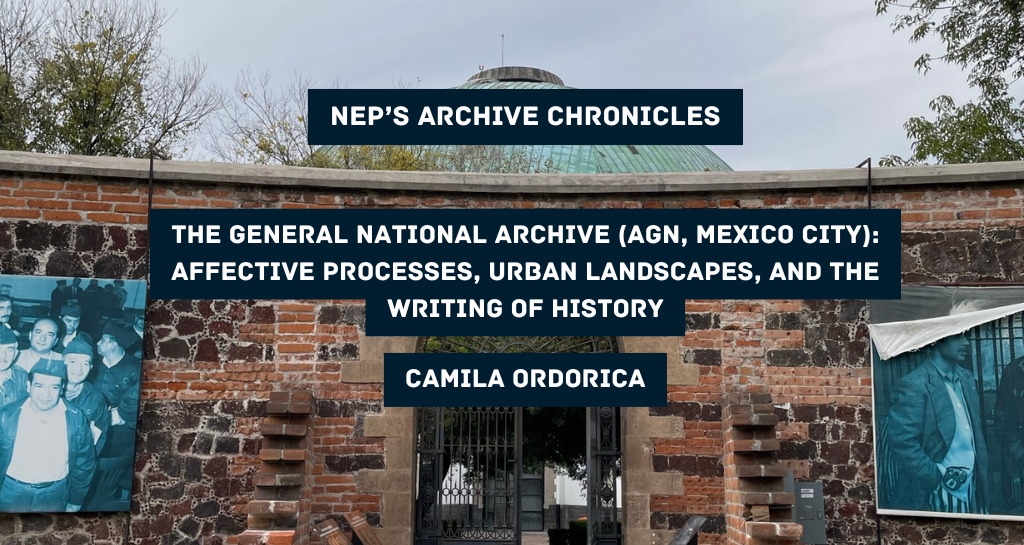
NEP’S Archive Chronicles explores the vital role archives play in historical research, offering insights into the process of conducting archival work. Each installment will provide a unique perspective on the treasures and challenges researchers encounter in the archives of the world. NEP’s Archive Chronicles aims to be both a practical guide and a reflective space, showcasing contributors’ experiences with archival research.
Nota: Haz click aquí para acceder a la versión en español.
Note: Click here to access Spanish version.
It feels almost too cliché of me to write that I was reading Arlette Farge’s The Allure of the Archives on the first day that I went to do research at the General National Archive (AGN) in Mexico City. But it’s true. I didn’t do it on purpose, I had been wanting to read the text for some time and had just gotten my hands on a used copy when I started researching the history of Mexico’s General Archive throughout the 19th century.
This happened three years ago, but I remember it clearly. I tend to forget things, but there where my social memory fails, my bibliographic memory is almost impeccable. I can remember all the books I have read. I know what the cover looks like, what size the book is, and where and when I read it. I remember how a book feels inside me, and I can reconstruct what it says or why it is important. Concerning Farge’s classic, I remember that the book is romantic, that she walked the corridors of the Judicial Archives in Paris looking for women in the sources, reflecting on the affectivity of the space, and I remember that I was reading it that day.
It was the middle of the summer, a gloomy and rainy day in the city, as the summer tends to be. It was also the middle of the COVID pandemic. The AGN was open, but their hours of operation were severely restricted, and so where the materials researchers could consult. I had made an appointment a week earlier to attend and see whether or not I could actually find anything. I had never really heard of the collection that I was looking for, but I was certain it existed. An archive should have a collection about its operations, right?
I left the house early, hopped on the metro, and soon arrived at the San Lázaro Station, in the center-east part of town. The metro station is named after the old San Lazaro railroad terminal, an important part of the Interoceanic railroad system on the Mexico-Puebla-Veracruz route. San Lázaro is always nothing less than chaotic. Not only are there two different metro lines that stop there, but the space is also shared with the Oriente Passenger Bus Terminal, or la TAPO as the locals call it. The station is one of the busiest in the city, with over 44,000 users crossing it per day. It took me a moment to find the Metrobus L5 after getting off the train, but I boarded it quickly. Just one stop later, I reached the station ‘Archivo General de la Nación’.[1]
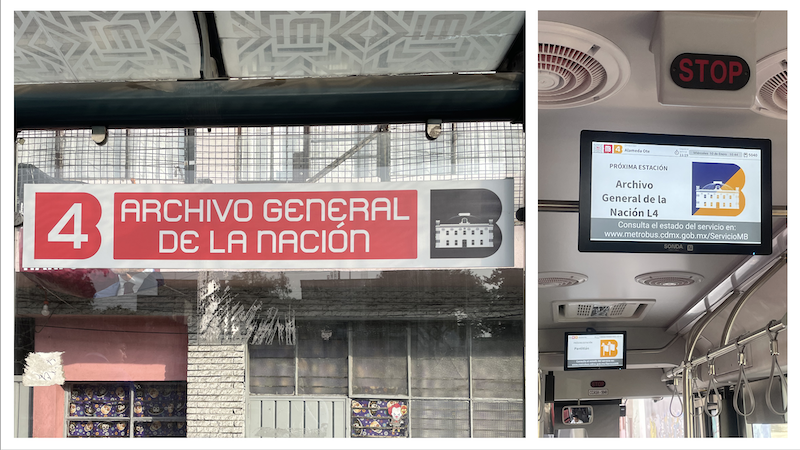
The AGN is currently housed in the Palace of Lecumberri. Originally inaugurated in 1900 by President Porfirio Díaz, the building was designed as a modern panoptical penitentiary. It served this purpose until 1972 when it was shut down due to a series of irregularities, corruption, and lack of space to sustain the growing inmate intake. After it shut down, a debate erupted in the Mexican press about its fate. Demolishing it would deprive both former inmates and the victims’ families of a significant place of memory. Additionally, opponents of its demolition emphasized the importance of preserving the building as a crucial site for studying and understanding the history of disciplinary architecture during the 20th century. But what to do with it?
A debate about the possible uses for the building erupted in the media. The controversy of “the historians”, represented by Edmundo O’Gorman, Eduardo Blanquel, Jorge Alberto Manrique, and architect Flavio Salamanca, was instrumental in the refurbishing of Lecumberri from a prison to an archive. Their arguments were mostly geared to the question of space. The historians were well aware that one of the key characteristics of archives is that they are always expanding and are driven and dependent on the acceleration of data accumulation and storage. Case point, the AGN, originally housed in the National Palace since its inauguration in 1823, had long run out of space and its collections were scattered across various locations in the city, including the National Palace, the Temple of Guadalupe in Tacubaya or the Yellow House, the Ciudadela, and the former Palace of Communications, today’s National Museum of Art (MUNAL).[2] Decentralization disrupted the office’s operations, jeopardizing user access. And the archive was only going to keep on growing, as archives do.
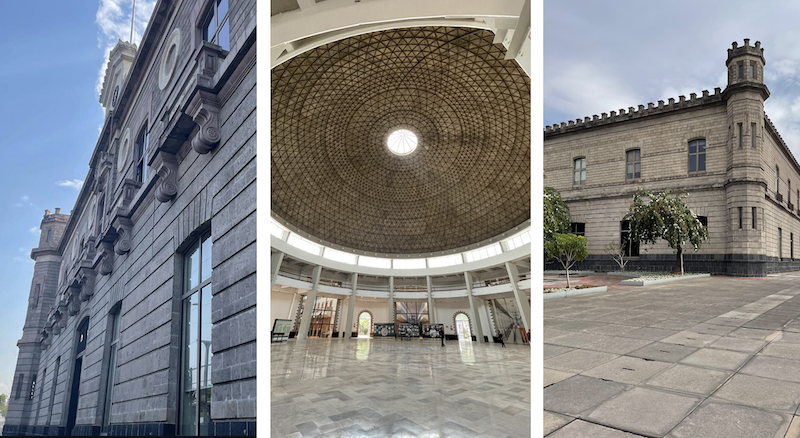
Aware of its present and future needs, personnel from the institution had been looking for solutions for this problem. José Ignacio Rubio Mañé, who served as the institution’s director from 1960 to 1977, even traveled the world through a government-funded program looking for inspiration in other archives scattered across the globe to improve the one he oversaw. But the project of refurbishing the Archive was cut short before completion.
And now, the solution was right there: Lecumberri. The building was already owned by the government, it was abandoned, and saving it would ensure its operations as a site of memory. As an additional and fortuitous element, it had been built to ensure surveillance practices, a much-needed component for archives. Archives place a high priority on vigilance because they store sensitive and unique documents that serve as the primary sources for the historical narratives of a given community in time. Their theft or damage can have social, material, and indeed emotional repercussions.
Lecumberri’s transformation into the new AGN’s headquarters was approved in 1977, and it moved locations in 1982 under the direction of Alejandra Moreno Toscano. The old prison cells were turned into vaults for document storage, and the long galleries of each one of the 5 arms of the prison were turned into reading rooms and office space. Though poetic, the lack of technical control—over climate and pests—that archivists could have over the documents inside the vaults pushed for the construction of the Technical Annex. Inaugurated in 2018, the annex is a modern and technological document storage facility that massively increased the storage space and modernized the systems. The cells now serve as office space for staff, and some of the long hallways have been refurbished for a mass-digitization project. Outside, the big white square building contrasts heavily with the nineteenth-century palace to its side. Two different strategies of technological innovation for the same end.
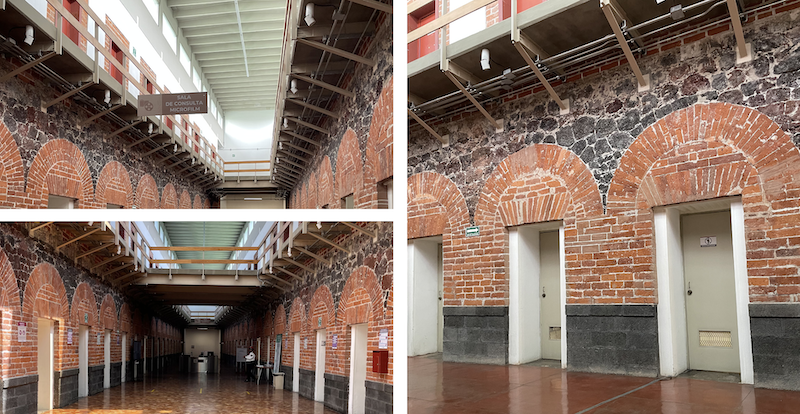
Upon arrival, I was greeted by two police officers. As in many archives across the world, I had to leave my bag, paper, pens, water, and any food in the lockers and register my identity and equipment with a valid ID. I gathered my computer, phone, gloves, and face mask, and headed to the reference center—a mandatory stop before entering the consultation rooms if you’re don’t know which collection you need to access. I really didn’t know where to find the institutional archive, so I talked to the archivists. My first conversation with the woman at the front desk—let’s call her M.—went something like this:
“Buenos días”.
“Buenos días”.
“What can I help you with?”
“I am looking for… I am looking for the archive of the Archive”.
“Excuse me?”
“Yes. I am looking for the archive of the Archive”.
I cannot help but laugh at the memory I have of M.’s face after my strange request. I explained to her that I was a historian, that I was researching the history of the National Archive, and that I was looking for the internal archive of operations of the AGN.
“There must be one, am I right?”.
“Ay, no sé la verdad, I have not heard of it. But why don’t try the general search engine and try to see what you find?”
I sat down and I typed the first thing I could think of: “archive”. But typing a word that is part of the name of the entire institution just ended up in me getting all of the databases transcribed into the results section of the program and crashing it.
I spent the next couple of weeks analyzing ArchiDoc, the AGN’s gigantic search engine system trying to figure out how to find this obscure collection that no one in the reference center had heard about. Until one day, early in the morning, M. approached me and told me about a collection she had seen on the Administrator profile of ArchiDoc. It was calledInstitutional Historical Archive (Archivo Histórico Institucional, AHI), and it was listed under 19th century.
Jackpot! As it happened, I had not seen this archive listed anywhere because the documents were being catalogued and processed, and it hadn’t been opened for consultation.[3] I shivered with excitement. I remember it so clearly. These documents constitute the history of the Archive through the bureaucratic paperwork of the administration of this institution. In fact, this was exactly what I was looking for: the archive of the archive. And it meant that my doctoral research was possible.[4]
The Institutional Historical Archive is divided in two mediums: volumes and boxes that contain files stored in acid-free yellow folders. The volumes are bound in leather that are roughly of 40cms x 25cms (15.75 in x 9.84 in), with page counts spanning from 250 to 450 pages per volume. It consists of 295 volumes spanning from 1825 to 1944, covering 119 years of archival administrative history. The collection demonstrates a significant increase in volume over time. The same pattern of growth is consistently observed, with increased numbers of documentation as the institution expanded. It’s contents are eclectic, ranging from reports, referrals, receipts, notes, instructions, and requests for information, among others. In these documents we can find the social, economic, political, material, and even affective worlds that have been an essential part in maintenance and up keeping of the institution and the materials within.

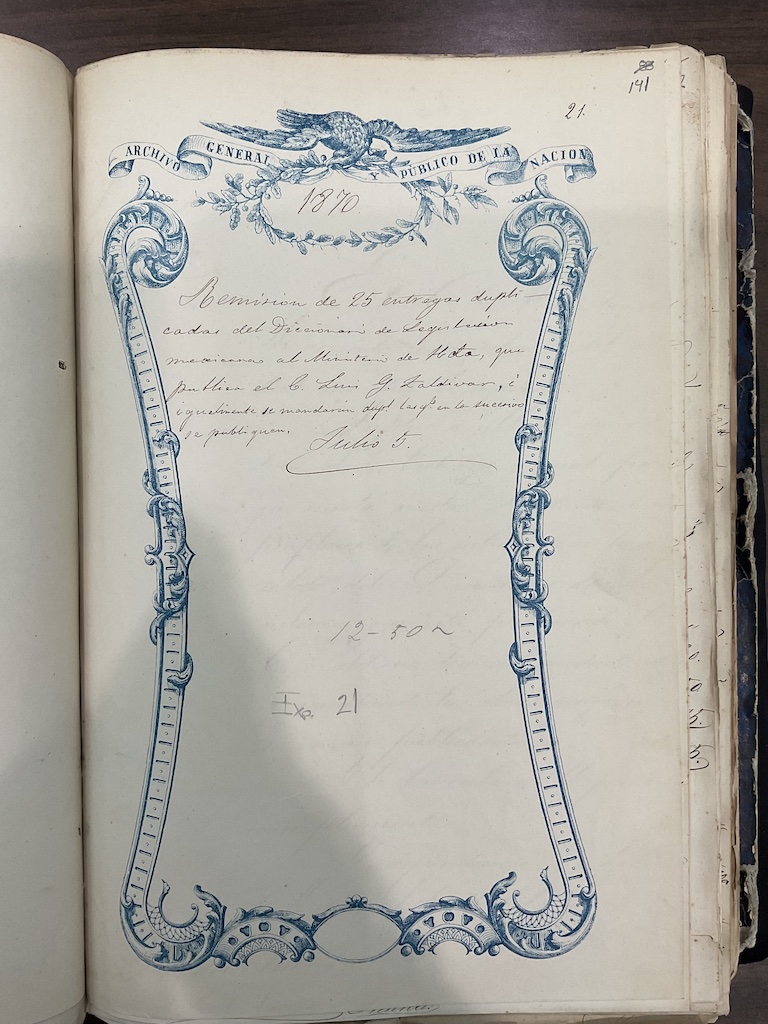
I was not able to look at the documents that year and had to wait until the following summer to do so, with prior approval of the Archive’s administration. Thankfully, historian and archivist Linda Arnold was kind enough to share with the Excel sheet of all the collection, which allowed me to process and understand the collection more deeply before I was able to look at the documents.
I traveled back to Mexico City as soon as I could, and headed straight to the AGN to look at the physical collection. By then I knew what the AHI was about, not now it was time to actually read it. I have since spent hundreds of hours crammed in the AGN’s Reading Room ‘A’ looking at the documents and taking pictures of the them for my research.
In these years, I have walked Lecumberri and taken loved ones on guided tours offered by the institution itself and have befriended some of the archivists. My research has also led me to other archives across Mexico and the world, where I have been looking at evidence that represents it as part of a global network of emerging information technologies in the 19th century.
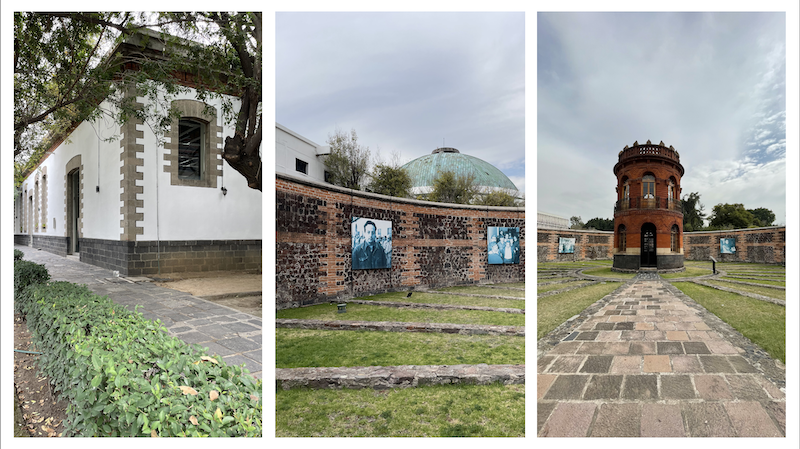
I have since started writing my thesis, and it should be done in the next couple of years. But writing this history is not without challenge. Archives are fragmented entities by nature and are constituted by silences and absences more so than by what they have successfully safe kept.[4] As the object of appraisal, the spoils of war, or the result of the volatile and unpredictable fragmentation of collections, what survives today is just a tiny fragment of what has ever been produced. This raises fundamental questions: Why has the history of archives not been analyzed in detail until recently? What does this tell us today? What types of histories can we retrieve from analyzing institutional archives of archives in detail?
It is precisely the fragmented nature of the AGN that has compelled me to explore more experimental forms of writing about its histories, leading me to approach its complexities through creative writing, particularly in the form of essay. Because by reflecting about the conditions under which history was archived, we gain insight into how it was lived and experienced, and we open up opportunities to reinterpret the formation of national identity and the past in new and unexplored ways.
Camila Ordorica is a doctoral candidate in Latin American History at the University of Texas at Austin, where she studies the history of the General Archive of Mexico during the long nineteenth century (1790-1910). Her research dialogues with archival, cultural, social, and material history, and explores how archives are written into history and their role within it. Camila’s passion for archival studies is rooted in her training as an archivist. Camila has worked at the Acervos Históricos de la Universidad Iberoamericana and the archives of Sine-Comunarr. She has also collaborated with UNAM’s ENES-Morelia, the ’17, Institute of Critical Studies’ and the International Federation of Public History in archival studies, practice, and digital humanities.
The views and opinions expressed in this article or video are those of the individual author(s) or presenter(s) and do not necessarily reflect the policy or views of the editors at Not Even Past, the UT Department of History, the University of Texas at Austin, or the UT System Board of Regents. Not Even Past is an online public history magazine rather than a peer-reviewed academic journal. While we make efforts to ensure that factual information in articles was obtained from reliable sources, Not Even Past is not responsible for any errors or omissions.
[1] I have since figured that the best route in public transport is going to Bellas Artes metro station and taking the Metrobus 4 directly to the AGN. There’s usually more traffic, but the ride is prettier. In the crisp morning air, you can take in the entire historic center, with its crooked buildings and bustling activity.
[2] Pereyra, Carlos, et al. Historia, ¿para qué? 1st ed. (México: Siglo Veintiuno, 1980)
[3] The AHI has not yet officially opened for consultation, but it is my understanding that it will be officially presented to the public before the end of the year.
[4] See: Jacques Derrida, Archive Fever. A Freudian Impression, (The University of Chicago Press, 1996); Michelle Caswell, Archiving the Unspeakable: Silence, Memory, and the Photographic Record in Cambodia, (University of Wisconsin Press, 2014); Verne Harris, Ghosts of Archive: Deconstructive Intersectionality and Praxis, (Routledge, 2021); Michel-Rolph Trouillot, Silencing the Past. Power and the Production of History, (Bacon Press, 1995)
